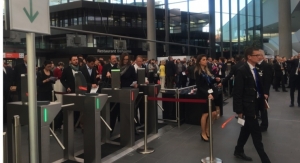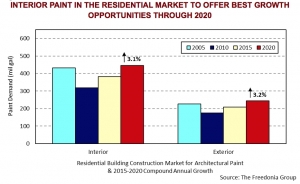11.17.16
World demand for emulsion polymers in paint and coatings (excluding paper coatings) is forecast to expand a healthy 5.4 percent per year to 5.0 million metric tons in 2020, the fastest growth of any major emulsion market. A continuing shift toward the use of waterborne latex paints -- a trend that is occurring in virtually all parts of the world -- is projected to fuel market gains. Advances are expected to be most pronounced in developing countries, as these markets have the most potential for replacement of solvent-based coatings as well as for more rapid growth in coatings production overall. Healthy growth in building construction activity in North America, combined with a turnaround in Western Europe, will also buoy gains. These and other trends are presented in Global Emulsion Polymers Market, 7th Edition, a new study from The Freedonia Group, a Cleveland-based industry research firm.
[link]
The reformulation of coatings from solvent-based to water-based systems is the primary strategy that paint suppliers employ to meet VOC requirements. The shift in the coatings product mix toward waterborne products has been most prevalent in North America and Western Europe, where emission limits are most stringent. However, waterborne technology is rapidly gaining favor throughout the world due to emissions legislation as well as performance advantages (e.g., durability, low odor, ease of application and cleanup).
In 2015, water-based paints accounted for just over half of total world paint and coatings output, with solvent-based paints, powder coatings, and radiation curables comprising the remainder. Waterborne types predominate in the architectural paint markets of most regions, with lower rates of use among developing countries (e.g., India) that still rely heavily on lower quality products. Output of water-based products in the Asia/Pacific region is also limited by the predominance of industrial over architectural paints in the large Japanese and South Korean coatings industries.
[link]
The reformulation of coatings from solvent-based to water-based systems is the primary strategy that paint suppliers employ to meet VOC requirements. The shift in the coatings product mix toward waterborne products has been most prevalent in North America and Western Europe, where emission limits are most stringent. However, waterborne technology is rapidly gaining favor throughout the world due to emissions legislation as well as performance advantages (e.g., durability, low odor, ease of application and cleanup).
In 2015, water-based paints accounted for just over half of total world paint and coatings output, with solvent-based paints, powder coatings, and radiation curables comprising the remainder. Waterborne types predominate in the architectural paint markets of most regions, with lower rates of use among developing countries (e.g., India) that still rely heavily on lower quality products. Output of water-based products in the Asia/Pacific region is also limited by the predominance of industrial over architectural paints in the large Japanese and South Korean coatings industries.








